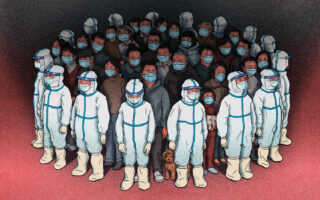New data links pandemic’s origins to raccoon dogs at Wuhan Market

An international team of virus experts said Thursday that they had found genetic data from a market in Wuhan, China, linking the coronavirus with raccoon dogs for sale there, adding evidence to the case that the worst pandemic in a century could have been ignited by an infected animal that was being dealt through the illegal wildlife trade.
The genetic data was drawn from swabs taken from in and around the Huanan Seafood Wholesale Market starting in January 2020, shortly after Chinese authorities had shut down the market because of suspicions that it was linked to the outbreak of a new virus. By then, the animals had been cleared out, but researchers swabbed walls, floors, metal cages and carts often used for transporting animal cages.
In samples that came back positive for the coronavirus, the international research team found genetic material belonging to animals, including large amounts that were a match for the raccoon dog, three scientists involved in the analysis said.
The jumbling together of genetic material from the virus and the animal does not prove that a raccoon dog itself was infected. And even if a raccoon dog had been infected, it would not be clear that the animal had spread the virus to people. Another animal could have passed the virus to people, or someone infected with the virus could have spread the virus to a raccoon dog.
But the analysis did establish that raccoon dogs – fluffy animals that are related to foxes and are known to be able to transmit the coronavirus – deposited genetic signatures in the same place where genetic material from the virus was left, the three scientists said. That evidence, they said, was consistent with a scenario in which the virus had spilled into humans from a wild animal.
A report with the full details of the international research team’s findings has not yet been published. Their analysis was first reported by The Atlantic.
The new evidence is sure to provide a jolt to the debate over the pandemic’s origins, even if it does not resolve the question of how it began.
In recent weeks, the so-called lab leak theory, which posits that the coronavirus emerged from a research lab in Wuhan, has gained traction thanks to a new intelligence assessment from the US Department of Energy and hearings led by the new Republican House leadership.
But the genetic data from the market offers some of the most tangible evidence yet of how the virus could have spilled into people from wild animals outside a lab. It also suggests that Chinese scientists have given an incomplete account of evidence that could fill in details about how the virus was spreading at the Huanan market.
Jeremy Kamil, a virus expert at Louisiana State University Health Sciences Center Shreveport who was not involved in the study, said the findings showed that “the samples from the market that had early Covid lineages in them were contaminated with DNA reads of wild animals.”
Kamil said that fell short of conclusive evidence that an infected animal had set off the pandemic. But, he said, “it really puts the spotlight on the illegal animal trade in an intimate way.”
Chinese scientists had released a study looking at the same market samples in February 2022. That study had reported that samples were positive for the coronavirus but suggested that the virus had come from infected people who were shopping or working in the market, rather than from animals being sold there.
At some point, those same researchers, including some affiliated with the Chinese Center for Disease Control and Prevention, posted the raw data from swabs around the market to GISAID, an international repository of genetic sequences of viruses. (Attempts to reach the Chinese scientists by phone Thursday were not successful.)
On March 4, Florence Débarre, an evolutionary biologist at the French National Center for Scientific Research, happened to be searching that database for information related to the Huanan market when, she said in an interview, she noticed more sequences than usual popping up. Confused at first about whether they contained new data, Débarre put them aside, only to log in again last week and discover that they held a trove of raw data.
Virus experts had been awaiting that raw sequence data from the market since they learned of its existence in the Chinese report from February 2022. Débarre said she had alerted other scientists, including the leaders of a team that had published a set of studies last year pointing to the market as the origin.
An international team – which included Michael Worobey, an evolutionary biologist at the University of Arizona; Kristian Andersen, a virus expert at the Scripps Research Institute in California; and Edward Holmes, a biologist at the University of Sydney – started mining the new genetic data last week.
One sample in particular caught their attention. It had been taken from a cart linked to a specific stall at the Huanan market that Holmes had visited in 2014, scientists involved in the analysis said. That stall, Holmes found, contained caged raccoon dogs on top of a separate cage holding birds, exactly the sort of environment conducive to the transmission of new viruses.
The swab taken from a cart there in early 2020, the research team found, contained genetic material from the virus and a raccoon dog.
“We were able to figure out relatively quickly that at least in one of these samples, there was a lot of raccoon dog nucleic acid, along with virus nucleic acid,” said Stephen Goldstein, a virus expert at the University of Utah who worked on the new analysis. (Nucleic acids are the chemical building blocks that carry genetic information.)
After the international team stumbled upon the new data, they reached out to the Chinese researchers who had uploaded the files with an offer to collaborate, hewing to rules of the online repository, scientists involved with the new analysis said. After that, the sequences disappeared from GISAID.
It is not clear who removed them or why they were taken down.
Débarre said the research team was seeking more data, including some from market samples that were never made public. “What’s important is there’s still more data,” she said.
Scientists involved with the analysis said that some of the samples had also contained genetic material from other animals and from humans. Angela Rasmussen, a virus expert at the Vaccine and Infectious Disease Organization at the University of Saskatchewan in Canada, who worked on the analysis, said that the human genetic material was to be expected given that people were shopping and working there and that human Covid cases had been linked to the market.
Goldstein, too, cautioned that “we don’t have an infected animal, and we can’t prove definitively there was an infected animal at that stall.” Genetic material from the virus is stable enough, he said, that it is not clear when exactly it was deposited at the market. He said that the team was still analyzing the data and that it had not intended for its analysis to become public before it had released a report.
“But,” he said, “given that the animals that were present in the market were not sampled at the time, this is as good as we can hope to get.”
This article originally appeared in The New York Times.






